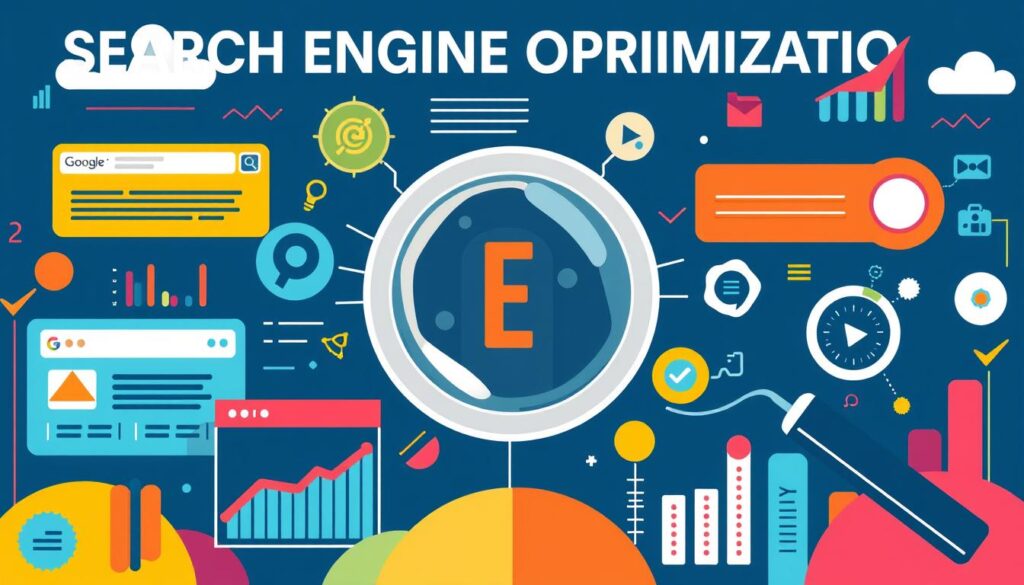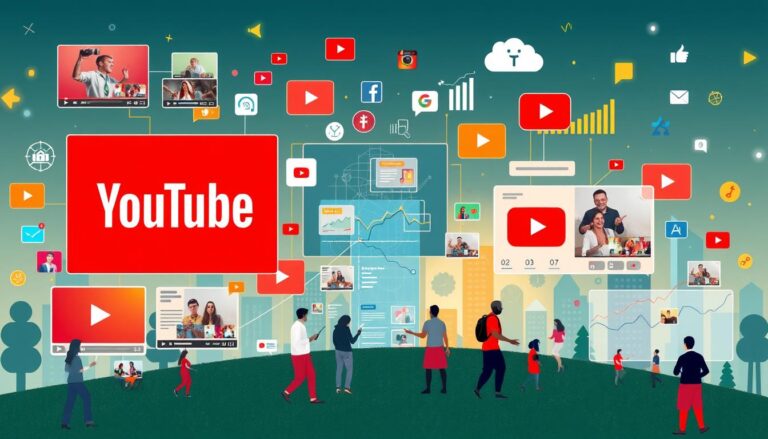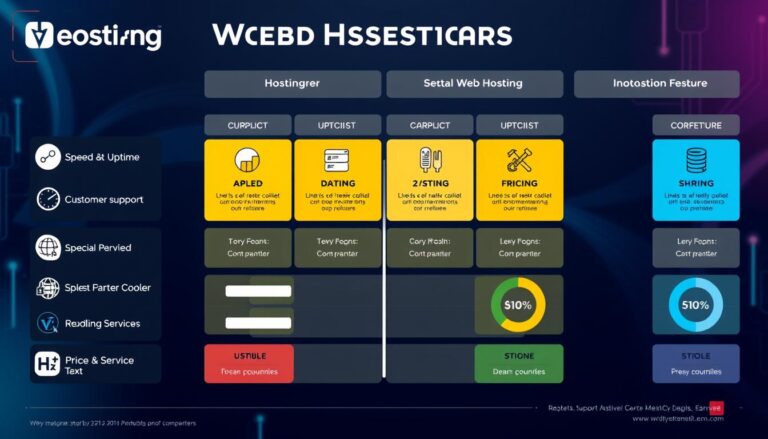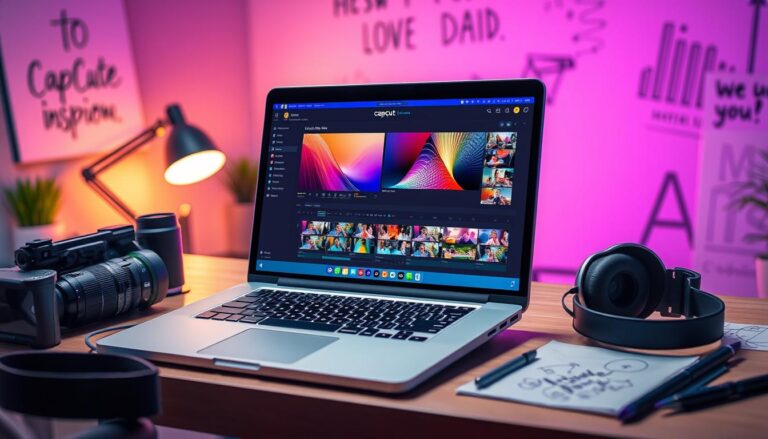SEO Best Practices for Higher Rankings and More Traffic
To get higher Google rankings, you need a smart SEO plan. Since 75% of people don’t look beyond the first page, knowing good SEO is key. It helps bring more visitors to your site.
Starting your SEO journey means learning important techniques. These can really boost how visible you are online. Remember, the top 5 results get 67% of all clicks. So, getting to the top is more vital than ever.
Good SEO isn’t about quick fixes. It’s about making content that’s valuable and meets people’s needs. You also need to optimize your online presence well. From finding the right keywords to technical tweaks, every step is important for your site’s search ranking.
Table of Contents
Understanding Search Engine Optimization Fundamentals
Search engine optimization is a fast-changing digital world. It needs a deep understanding of how search engines find, process, and rank web content. Your website’s visibility depends on knowing how search engine algorithms work.

Search engines use special programs called crawlers to explore the internet. These digital explorers go through websites, collecting and analyzing content. They build detailed indexes this way.
How Search Engines Crawl and Index Content
Crawling is the first step in finding content. Google’s crawlers automatically scan websites. They look at:
- Website structure
- Content relevance
- Internal linking patterns
- Page metadata
Key Ranking Factors in Modern SEO
Today’s search engine algorithms look at many things when ranking pages. The most important factors are:
| Ranking Factor | Impact Level |
|---|---|
| Content Quality | High |
| Backlink Profile | High |
| Page Loading Speed | Medium |
| Mobile Responsiveness | Medium |
The Role of User Experience in SEO
User experience is now a key ranking factor. Search engines like Google favor websites that offer smooth, easy interactions. Engagement metrics like time on site, bounce rate, and click-through rates affect search rankings.
“Great SEO is about creating an exceptional user experience that naturally attracts search engine recognition.”
By grasping these basic SEO principles, you can create strategies to boost your website’s visibility and organic traffic.
Keyword Research and Implementation Strategies
Discovering the right keywords is key to SEO success. Tools like Moz, SEMrush, and Ahrefs help find valuable search terms. These terms can bring targeted traffic to your site. It’s important to understand what people are searching for and choose keywords that match.

- Look into long-tail keywords with less competition
- Check search volume and what users are looking for
- Use Google autocomplete for more ideas
- Go for specific search phrases that fit your niche
Think about the power of strategic keyword placement. Your chosen keywords should fit naturally into:
- Page titles
- Header tags
- Meta descriptions
- Content body
“Effective keyword research is about quality, not just quantity” – SEO Expert
| Keyword Type | Search Volume | Difficulty |
|---|---|---|
| Small Business SEO | 2,500 | Very High |
| SEO Tips for Small Businesses | 300 | High |
The aim is to make content that ranks well and offers real value. By picking and using keywords wisely, you’ll draw more organic traffic.
On-Page SEO Best Practices
Improving your website’s search engine rankings is key. Search engines look for specific signals from your web pages. By using on-page SEO, you can make your site more visible and attract more visitors.
Crafting Compelling Title Tags
Title tags are your first chance to talk to search engines and visitors. Google says keep them short, under 60 characters. Here’s what to do:
- Put primary keywords at the start
- Make each title unique
- Show what the page is about
Meta Description Strategies
Meta descriptions are vital for getting people to click on your site from search results. Even if Google changes them, writing good descriptions is still important. Here’s how:
- Keep them under 160 characters
- Include your main keyword
- Show what makes your page special
- Avoid tricks to get clicks
Optimizing Content Structure
Good header tags help both search engines and users find their way through your content. Use HTML tags (H1, H2, H3) to organize your content well. Structure is as important as the content itself.
Image SEO Techniques
Optimizing images is more than just making them look good. Compress images, use clear filenames, and always add alt text. These steps help search engines understand your images and make your site faster.
“Great content is the best SEO strategy you can implement” – Neil Patel
Creating High-Quality Content That Ranks
Creating top-notch content is key to a great content marketing plan. You want to make stuff that’s not just good but also ranks well online. Google loves content that’s really useful and meets what users need.
- Make evergreen content that stays relevant for a long time
- Do deep research to share complete insights
- Know and meet specific user needs
- Add original data and fresh views
“Content quality is not about word count, but about providing genuine value to your audience.” – SEO Expert
Updating your content should be smart and focused. Studies show top content is usually around 1,447 words. But it’s not just about how long it is. Look at different user needs to make content that hits the mark:
| User Intent | Content Focus |
|---|---|
| Purchase | Detailed product info, customer feedback |
| Compare | Problem-solving, focusing on benefits |
| Learn | Deep, expert content |
Your content plan should follow the E-A-T rule (Experience, Expertise, Authoritativeness, Trust). This means your content should show you really know your stuff, use trusted sources, and offer practical tips.
Pro content makers know ranking well is an ongoing job. They keep improving by updating content, doing thorough research, and focusing on what users want.
Technical SEO Optimization Guide
Technical SEO is key to your website’s success. It makes sure search engines can find and rank your content well. It also makes sure users have a great experience.
Using strong technical SEO can really boost your site’s visibility. Search engines love websites that work smoothly.
Site Speed and Performance
Fast page speed is important for ranking. Google’s PageSpeed Insights shows fast sites rank better.
- Compress images using tools like ShortPixel
- Minify HTML, CSS, and JavaScript files
- Leverage content distribution networks (CDNs)
- Enable browser caching
Mobile-First Indexing
Mobile-friendly design is now a must. Google indexes mobile versions first. Responsive design is essential.
“Your mobile site is your primary site in Google’s eyes.” – SEO Expert
XML Sitemaps and Robots.txt
XML sitemaps and robots.txt files are crucial. They help search engines find and understand your site.
- Create comprehensive XML sitemaps
- Submit sitemaps through Google Search Console
- Configure robots.txt to manage crawler access
- Implement HTTPS for secure connections
Regular technical SEO checks are vital. They help find and fix issues that could hurt your site’s performance. This keeps your site competitive.
Link Building and Authority Development
Building high-quality backlinks is key to boosting your website’s domain authority and search rankings. Google’s PageRank algorithm still values both the number and quality of links.
Good link building means focusing on quality over quantity. The best backlinks come from:
- Highly authoritative websites in your industry
- Relevant content that naturally connects to your site
- Editorially-placed links within main content areas
- Original research and unique visual assets
“Not all links are created equal. The right backlink can dramatically improve your search engine visibility.”
Your outreach should aim at websites with high domain authority. Semrush’s Authority Score is a great tool for finding good linking opportunities. Key strategies include:
- Creating linkable content assets
- Conducting original research
- Developing infographics and data visualizations
- Engaging in strategic guest posting
Knowing where to place links is important. Links in the main content are more valuable than those in footers or sidebars. Use descriptive anchor text, but avoid too many keywords.
Keep track of your link building success by watching referral traffic, keyword rankings, and domain authority. Always choose ethical and sustainable link building over manipulative methods.
| Link Type | SEO Value | Ranking Impact |
|---|---|---|
| Authoritative Site Links | High | Significant |
| Relevant Industry Links | Medium-High | Moderate |
| Low-Quality Links | Low | Minimal/Negative |
User Experience and Site Architecture
Creating a great user experience begins with smart site architecture. Your website’s layout is key for both search engine ranking and user satisfaction. A well-organized site can lower bounce rates and boost how long users stay.
Good UX design is more than just looks. It’s about making navigation easy and straightforward. Here are some tips for improving your site’s structure:
- Limit site hierarchy to four levels or fewer
- Create clear, logical navigation menus
- Implement descriptive URLs
- Ensure all important pages are accessible within three clicks
“Good navigation is invisible – users should never feel lost on your website.”
Internal linking is vital for site architecture. It helps search engines see how your content is connected and makes browsing easier for users. Use internal links wisely to:
- Connect related content
- Pass page authority
- Improve overall site indexing
Your aim is to make a site that meets both user and search engine needs. Focus on easy navigation and clear content organization. This way, your website will be a hit with both users and search engines.
Local SEO and Voice Search Optimization
Digital marketing is changing fast with voice-activated tech. Businesses need to update their local search plans to keep up. Voice search is key for reaching today’s consumers who use digital assistants a lot.
- 40% of U.S. internet users use voice assistants every month
- 58% of consumers look up local business info with voice search
- Smart speaker use is expected to hit 200 million by 2023
Google Business Profile Optimization
Your Google Business Profile is key for local search visibility. Make sure it’s filled out with the right info, good photos, and current hours. Ask customers for reviews and answer them fast to look credible.
Local Citation Building
Having consistent local citations helps your business’s online presence. Keep your Name, Address, and Phone Number (NAP) the same everywhere. This shows search engines you’re trustworthy and boosts your local search ranking.
Voice Search Considerations
Voice searches are different from text searches. They’re more like conversations and questions. Make your content sound natural and use long-tail keywords that match how people talk.
“The future of search is conversational and local” – Digital Marketing Expert
| Voice Search Strategy | Key Actions |
|---|---|
| Content Optimization | Use conversational language |
| Technical SEO | Implement schema markup |
| Local Targeting | Optimize for location-specific queries |
By using these strategies, you’ll get ahead in the voice search world. This will also help your local search visibility.
Measuring SEO Success with Analytics
Tracking your SEO performance needs smart use of tools like Google Analytics and Search Console. These tools show how your site does in search results and connects with visitors.
Important SEO metrics give key insights into your digital marketing plan. You should look at several key performance indicators:
- Organic traffic volume
- Keyword rankings
- Click-through rates
- Conversion tracking
- User engagement metrics
Knowing these metrics helps you make smart choices. Search Console shows which keywords bring in the most visitors. Google Analytics tells you how users behave.
“Numbers tell a story – your job is to listen and adapt.”
To really measure SEO success, track these important metrics:
| Metric | Importance | Key Insights |
|——–|————|————–|
| Organic Traffic | High | Measures unpaid search visits |
| Keyword Rankings | Medium | Shows content visibility |
| Click-Through Rate | Critical | Indicates content relevance |
| Bounce Rate | Important | Reveals content engagement |
| Conversion Rate | Essential | Tracks business impact |
Experts say to check these metrics every 3-6 months. Small tweaks based on data can greatly boost your site’s search engine ranking.
SEO is a continuous effort. Keep watching and tweaking to keep your site visible and drive business growth.
Conclusion
Your SEO journey is a continuous effort that needs constant focus and smart adjustments. Search engine algorithms keep changing, so you must always improve. To succeed in digital marketing, you need to be quick to adapt to new trends and tech.
SEO is not a one-time job but a constant strategy. You should regularly check your website, look at your performance, and make changes. Tools like Google Analytics and SEMrush help you see how you’re doing and where you can get better.
With artificial intelligence changing the web, your SEO plan must get more complex. Google’s AI now looks at how well your site works, how relevant your content is, and what users want. So, you should aim to make content that really helps your audience, use keywords wisely, and keep your site technically sound.
SEO success takes time and effort, not just a quick fix. Being patient and always ready to learn and change will help your site do well. By keeping up with new trends and focusing on giving value to your users, you can create a strong online presence in a competitive world.







